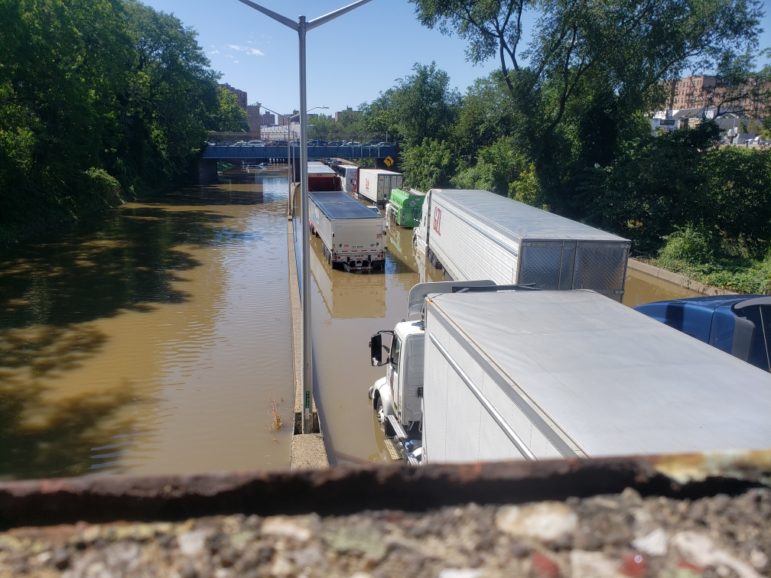‘Acknowledging the inequitable distribution of climate change’s damage is an important step, but we must do better. Those with the fewest resources should not have to shoulder the full burden of the damages primarily caused by the wealthy. Climate attribution systems are the step forward.’

Jarrett Murphy
Trucks flooded along the Major Deegan Expressway near 234th Street in the Bronx after Hurricane Ida.The Build Back Better legislation had the potential to drastically cut greenhouse gas emissions across the U.S. and strengthen our fight against climate change. But now that it’s effectively dead, thanks to Sen. Manchin, the U.S. will continue to be one of the greatest contributors to global climate change. Meanwhile, as the COP26 finally acknowledged earlier this year, climate change makes extreme weather more extreme, and the damages caused by climate change are vastly inequitable.
There must be accountability for those who contribute the most to climate change—but first we need systems in place, both internationally and locally, that give transparency to the inequitable causes of climate change and its resulting damages.
2021 has been one of the hottest years on record, full of extreme weather and “natural” disasters. With apologies to William Shakespeare and John Steinbeck, it was “the summer of our discontent.” In the wealthiest nation on the planet, the destruction caused by climate change falls hardest on those who have the fewest resources to be resilient and recover from disasters.
When the remnants of Hurricane Ida brought extreme rainfall to New York City, it caught many by surprise and unnecessarily took the lives of 16 New Yorkers. Those lives lost didn’t belong to wealthy, white residents—they were mainly people of color living in garden and basement apartments in low-income neighborhoods. What happened this summer in New York is the continuation of devastating trends that have grown with the threat of climate change: extreme heat hits Black and brown neighborhoods the hardest, and low-income communities of color see higher rates of pollution.
We see versions of the climate racism and classism that occurs in New York in every American city, and they are all microcosms of the devastating and inequitable effects of climate change that happens worldwide. When developing countries like Nicaragua and Bangladesh experience flooding, that flooding is made worse not by their own carbon emissions, but by the massive amounts of carbon emitted by the U.S. and other developed countries.
Acknowledging the inequitable distribution of climate change’s damage is an important step, but we must do better. Those with the fewest resources should not have to shoulder the full burden of the damages primarily caused by the wealthy. Climate attribution systems are the step forward.
We must invest in climate change attribution technology, which can measure how much worse an extreme weather event was made by the human consumption of fossil fuels. Stony Brook University’s Climate Extremes Modeling Group is one of several teams that is already able to quantify how climate change is impacting extreme weather events in near-real time.
This methodology can be expanded to assess which portion of an extreme weather event’s losses and damages are attributable to climate change, providing transparency to climate change’s inequalities. For example, when extreme weather causes flooding in Bangladesh, this technology can show how much worse that weather was made by climate change, and then wealthy countries that contribute the most to climate change can foot the recovery bill.
On a more local level, we must develop similar technology to show the ways that wealthy, carbon-intensive Americans contribute to climate change at a higher rate while experiencing less of its destruction. This type of technology is what Stony Brook University hopes to develop at our proposed Governors Island Climate Center. Bringing the Climate Extremes Modeling Group to the table, along with local communities and government, we can create methodologies and policies that implement a high level of transparency around carbon emissions and climate change in New York City and across the country.
There’s also a major need for better early warning systems. Nobody should be blindsided by extreme weather events. When lives are lost to storms that can be predicted in advance, that’s negligence. Governments have a responsibility to protect the lives of those most vulnerable. In addition to forecasting extreme weather events, plans must be made and implemented in advance to reduce or avoid suffering when extreme weather does occur.
There’s a general lack of common language and understanding around climate risks and solutions, and there’s a major need to bring communities together to solve these problems. Transparency can help us get there. If we don’t invest in the technology that will allow us to take more meaningful action to reduce the escalation of climate change and its inequitable effects, with every passing year we’ll experience summers of more and more discontent.
Kevin Reed is an associate professor and associate dean for research at Stony Brook University’s School of Marine and Atmospheric Sciences. Michael Wehner is a senior staff scientist at the Lawrence Berkeley National Laboratory.








